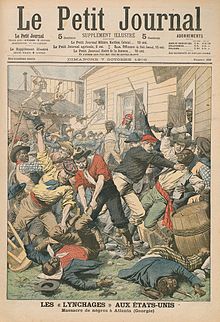
Back Massaker von Atlanta German Disturbios raciales de Atlanta de 1906 Spanish Émeutes d'Atlanta de 1906 French Motim de Atlanta de 1906 Portuguese Резня в Атланте 1906 года Russian
| 1906 Atlanta massacre | |
|---|---|
| Part of the Nadir of American race relations | |
 The cover of French magazine Le Petit Journal in October, 1906, depicting the Atlanta race riot | |
| Location | Atlanta, Georgia |
| Date | September 22–24, 1906 |
| Target | African Americans |
| Deaths | 25+ African Americans, 2 white Americans |
| Injured | 90+ African Americans, 10 white Americans |
| Perpetrators | White mobs, and Fulton county police. |
The 1906 Atlanta Race Massacre, also known as the 1906 Atlanta Race Riot, was an episode of mass racial violence against African Americans in the United States in September 1906. Violent attacks by armed mobs of White Americans against African Americans in Atlanta, Georgia, began after newspapers, on the evening of September 22, 1906, published several unsubstantiated and luridly detailed reports of the alleged rapes of 4 local women by black men. [1] The violence lasted through September 24, 1906.[2] The events were reported by newspapers around the world, including the French Le Petit Journal which described the "lynchings in the USA" and the "massacre of Negroes in Atlanta,"[3] the Scottish Aberdeen Press & Journal under the headline "Race Riots in Georgia,"[4] and the London Evening Standard under the headlines "Anti-Negro Riots" and "Outrages in Georgia."[5] The final death toll of the conflict is unknown and disputed, but officially at least 25 African Americans[6] and two whites died.[7] Unofficial reports ranged from 10–100 black Americans killed during the massacre.[8] According to the Atlanta History Center, some black Americans were hanged from lampposts; others were shot, beaten or stabbed to death. They were pulled from street cars and attacked on the street; white mobs invaded black neighborhoods, destroying homes and businesses.
The immediate catalyst was newspaper reports of four white women raped in separate incidents, allegedly by African American men. A grand jury later indicted two African Americans for raping Ethel Lawrence and her niece Mabel Lawrence. An underlying cause was the growing racial tension in a rapidly-changing city and economy, competition for jobs, housing, and political power.
The violence did not end until after Governor Joseph M. Terrell called in the Georgia National Guard, and African Americans accused the Atlanta Police Department and some Guardsmen of participating in the violence against them. Local histories by whites ignored the massacre for decades. It was not until 2006 that the event was publicly marked – on its 100th anniversary. The next year, the Atlanta massacre was made part of the state's curriculum for public schools.[9]
- ^ Kuhn, C. & Mixon, G., "Atlanta Race Massacre of 1906" Georgia Humanities (2022) [1]
- ^ Charles Crowe, "Racial Massacre in Atlanta: September 22, 1906." Journal of Negro History 54.2 (1969): 150–173. online
- ^ "Un lynchage monstre" (September 24, 1906) Le Petit Journal
- ^ "The Race Riots in Georgia". Aberdeenshire, Scotland. Aberdeen Press and Journal. September 25, 1906. p. 6.
- ^ "Anti-Negro Riots". London, England. London Evening Standard. September 26, 1906. p. 7.
- ^ Burns, Rebecca (September 2006). "Four Days of Rage". Atlanta Magazine: 141–145.
- ^ "Whites and Negroes Killed at Atlanta; Mobs of Blacks Retaliate for Riots – Two Whites Killed; Many Negroes Surrounded; Two of Band That Killed an Officer Try to Escape, but Are Captured and Lynched." (September 25, 1906) New York Times
- ^ "The 1906 Atlanta Race Massacre: How Fearmongering Led to Violence". November 8, 2022.
- ^ Shaila Dewan, "100 Years Later, a Painful Episode Is Observed at Last", New York Times, 24 September 2006; accessed 30 March 2018
© MMXXIII Rich X Search. We shall prevail. All rights reserved. Rich X Search